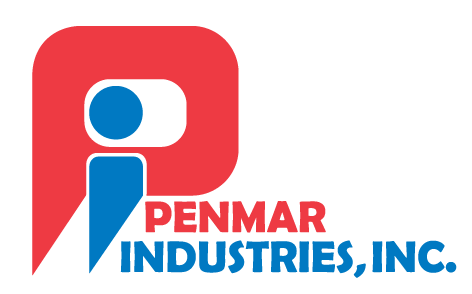By Jack Kenny – In some ways, Penmar Industries is a perfect example of the type of label printing plant that is ubiquitous across the globe: small, family owned, employing a modest cadre of workers, maintaining a small group of presses, and cranking out good quality work that keeps the business and the community alive.
In other ways, however, Penmar Industries stands well apart from the small converting operation. It is investing strongly in marketing to gain share in the niches it serves best. It has satisfied the requirements of ISO 9001:2000 and proudly displays the certification. It is a practitioner of Lean Manufacturing principles with success stories to tell. It’s a company that has been in business for more than 40 years, and it doesn’t consider itself to be like anyone else, thank you.
Penmar Industries, located in Norwalk, CT, USA, is actually two companies. One division is a supplier of packaging materials and tapes, distributing for different manufacturers of corrugated and folding cartons. It’s also part owner of SpecTape, a business in Erlanger, KY, USA, that manufactures and converts pressure sensitive tapes. The packaging materials division along with the label division has an annual turnover of just under $5 million, says President Ed Rodriguez.
The label converting operation is a flexo shop, producing custom labels on three classic Webtron presses and, when needed, on the company’s very first press:?a 9″ one-color International. Penmar is also heavy on academic talent. Soegaard has engineering degrees from the University of Puerto Rico and from Texas A&M. The operations and general manager, J. Rick Cipot, is an Oxford University graduate with an MBA from the University of Connecticut.
Penmar’s founder was James Penders, who started the business in 1964, incorporating in 1967 in New Rochelle, NY, about 40 minutes west of Norwalk. It made the move to Connecticut in 1971, having gotten into the label printing business in the intervening years.
As Cipot tells it, a packaging materials customer came to Penmar with an inquiry about sourcing a label. “It was a simple order with repeatability, and they sat back and said, ‘Can we do this?’ That was the beginning: One employee, one press (one color), one roll supplier, one customer with one product. And that got them into the label printing business.”
Soegaard and his wife, Libby, bought the company in 1992. Prior to that, he had been vice president of sales (and operations as well) for the company, having enhanced his engineering background with additional courses in sales, marketing and finance.
“When we took over we put more emphasis on label production,” Soegaard says. “We modernized, put in some new converting and inspection equipment. And we put more emphasis on custom label production. That’s partly due to Rick’s expertise. He’s a very computer savvy person, and heavily involved with quality control and quality standards. We are now ISO 9001:2000 certified; he started that certification process. We have been working with CONNSTEP to bring Lean Manufacturing here. We received a grant from the state to help us get certified and then go through the Lean process. There is still more work to be done – it never stops.”
Penmar’s stepped-up marketing efforts these days involve pursuing companies who need UL certification for their products. “We are targeting OEM manufacturers who require UL recognition. We have been able to guide some of our most recent customers who are looking for UL certification and need to go through that process. We are continuing to offer that to companies in our region that may not know that we have that type of service, as well as other types of labels, tapes and packaging materials. If you have a manufacturing facility, more than likely you will need packaging materials as well as labels.”
The company also has made good use of its membership in the Connecticut Minority Supplier Development Council. Soegaard, who is Hispanic, says that the council “has helped us get in front of a lot of major corporations.” The council is an entity that certifies a business as minority owned. “If you go through the certification process, it opens a network with a lot of companies that want to do business with minority owned companies,” he says. “What it does is open the door, but it doesn’t guarantee that you are going to get any business. It just assures you of the opportunity.”
Cost reduction for customers
How is Penmar handling the cost increases that all businesses are faced with today? “In some cases we can pass the increases along, and in some cases we do not. Sometimes we have offered other products to our customers to replace some of the more expensive materials, and sometimes we have been successful,” says Soegaard. “We are still looking for savings by going to other suppliers who can help us keep costs the same, and in some cases lower costs. We keep looking for alternatives, now more than ever.”
Penmar employs 15 to 16 people, and no jobs have been lost. The company now is keeping less inventory – part of the Lean process – “and that has helped with cash flow,” Soegaard notes. “We have also worked with suppliers to get more favorable terms, because a lot of our customers have been asking us for longer payment terms.”
Cipot adds that one customer writes every year insisting on price reductions. “This year we were proactive, researching new materials to replace existing materials being used on their product line. We presented them with two alternatives to help them reduce costs. We are now in production with new materials, and we are saving them 4.5 percent below the cost they were paying 18 months ago.”
Cipot has been with Penmar for 14 years, having served as director of commercial graphics for PepsiCo for seven years prior. He loves the label business.
“The first time we went through the Lean process, I made a huge mistake. I set our goals very high, which was a wonderful learning experience. We were monitoring everything, and began to look at our scrap waste. My goal was to reduce scrap waste by 50 percent. That was a huge goal, especially in the web industry. Small short runs waste more material than we ship. Within six months we had met that goal. We are setting up more often on overrun roll material than what we used to start up on. Butt rolls that used to go into the waste bin are now going into press setup. So now you are 80 percent to target before you put in the good roll material.
“We met that goal, and began looking at ontime shipping: How are customers perceiving us and are we meeting their goals? Darn it! We’re too good. We are at 87 percent for packaging and 93 percent approval for labels.”
Cipot has nothing but praise for the members of the company’s production team. “Penmar Industries’ biggest and best asset is the production employees. We could not be in the position that we are in today without them. They have ownership of the daily operations of this company. If there’s a problem they will solve it or come to some other resolution, or move onto something else until I’m available to consult with them. This has increased our productivity by 23 percent.”
Self-government and ownership
“What we have done is give production personnel the OK to self-govern. It has been absolutely fantastic. I’m there to help, to fix, to make sure everything is on track, but at the same time, production employees are self-empowered to get the work done. They know where the paycheck comes from. It doesn’t come from me and it doesn’t come from Tony. It comes from the job going out the door on time of the highest quality possible to meet or exceed the customer’s expectations. That’s the paycheck.
“It’s a lot of fun. I am really proud of the employees of this company. Without the people in production, we would not be here today. I took a Friday off recently, and got a call at 2 p.m. from the head pressman, who said: ‘We’d like to come in tomorrow to work.’ They were concerned about some of the ship dates, and figured if they could work five hours on a Saturday we wouldn’t have to worry about any ship dates at all. How many employees do that?
“Ownership is huge in this company,” Cipot says. “How do you prevent a press from going down? You listen to it, you watch it, you baby it, you take care of it. You will never, ever find one of our pressmen reading a book or a magazine or staring out the window.
“Something I learned a long time ago is that your press sings to you. It has a rhythm, a sound, and when everything is right, you hear that it’s right. It doesn’t take long to learn the rhythm, and once you start listening to it, you’ll know when something is going to go astray. You’ll hear it happen before it happens. We’ve spent a lot of time teaching it to the people here, and that’s why we haven’t had any major repairs to our presses for nearly a year.”

